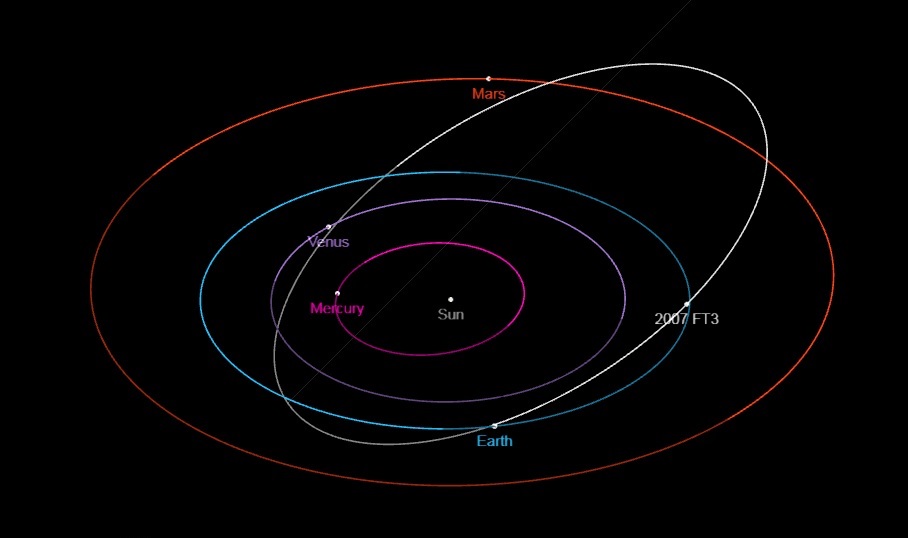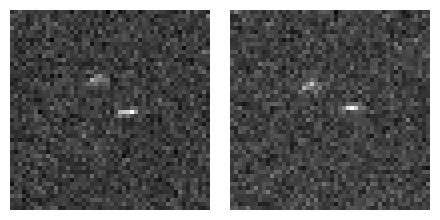The asteroid hazard is the only space threat to Earth against which we already have at least some protection. Of course, the methods of deflecting small bodies of the Solar System from the collision course with our planet are still far from perfect, but they have already proved their effectiveness by the example of the collision of the DART probe with the Dimorphos asteroid. Anyway, we need at least to know its exact position in interplanetary space in order to somehow influence the trajectory of a dangerous object and therefore closely monitor it with the help of ground-based and orbital telescopes. Unfortunately, this is not possible in all cases.
Asteroid 2007 FT3 was discovered on March 20, 2007, in the survey images of the celestial sphere obtained at the Mount Lemmon Observatory (Arizona). Unfortunately, it was possible to track it for too short a period of time — less than two days. Therefore, its orbit was calculated very inaccurately and did not allow predicting the movement of this body far enough into the future to find it by calculations. Estimates of the size of the 2007 FT3 also lie in a fairly wide range — from 270 m to half a kilometer.

Calculations indicated that the orbit of the new object should be very close to the Earth’s at the point that our planet passed on October 2–3. Their next “date” was to take place in 2013, when astronomers had the opportunity to rediscover the lost asteroid, taking advantage of its relatively high brightness and rapid movement against the background of stars. Several American and Australian observatories took part in the search, but without success.
It is easy to understand that over time, since the last observation, the accuracy of predicting the position of a celestial body has decreased. Therefore, for the approach from 2007 FT3, “planned” for October 2–3, 2019, astronomers calculated the minimum distance to Earth of about 0.15 AU (22 million km), but the possible deviation was about twice as large. That is, on the specified date, the object could be at any point of a sphere with a radius of 40 million km, inside which our planet was located. This meant the probability of a collision at the level of one forty-millionth – that is, the square of the ratio of this radius to the corresponding indicator of the Earth. As we already know, the asteroid “missed” it again, but it also did not get into the field of view of the telescopes searching for it.

On October 5, 2024, according to calculations, the “date” from 2007 FT3 may take place again. The accuracy of determining the relative position of the Earth and the asteroid continues to decrease, and therefore the probability of a collision decreases. Space is large enough for even much larger bodies to “miss” it without problems, so the only thing scientists expect from the predicted approach is that the lost “heavenly rock” will finally be found and its exact orbit determined, after which it will receive an official number and name.
By the way, there has already been a case of such a “loss” in the history of astronomy, found as much as 66 years later. On a photographic plate taken on October 28, 1937, at the Heidelberg Observatory, its employee Karl Reinmuth noticed a long black track of an object that flew very close to the Earth — as we now know, at a distance of 740 thousand km. Further observations were prevented by bad weather, and telegraphic messages sent to other observatories arrived too late. The mysterious asteroid was named after the ancient Greek god of commerce and travelers Hermes, but the number 69230 was assigned to it only in 2003, when it was accidentally rediscovered during a sky survey as part of the LONEOS project. Extrapolation of the asteroid’s orbital motion into the past allowed us to detect another approach to our planet, which happened on April 26, 1942 — then we were separated from it by only 635 thousand km (less than two average radii of the lunar orbit). However, at that time, due to the events of the Second World War, astronomical observations were conducted sporadically, and the chance to rediscover this celestial body was missed. Obviously, there was no collision with it then.

Hermes, which has an orbit inclined to the ecliptic by 6°, is a much greater potential threat to the Earth than 2007 FT3, which has a figure of about 27°. In addition, as already known, it is a double system of two bodies measuring 630 and 550 m, that is, it is twice as dangerous. But in this case, the media never made much noise, even though this body remained “unnoticed” for almost 66 years, continuing to fly very close to us by the standards of the Solar System. So all forecasts regarding the “October 5th clash” are actually focused only on loud headlines…
As we already wrote, the periodic comet Tsuchinshan-1 will approach the Earth at the end of January.
Follow us on Twitter to get the most interesting space news in time
https://twitter.com/ust_magazine


